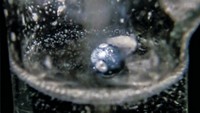Advertisement
Grab your lab coat. Let's get started
Welcome!
Welcome!
Create an account below to get 6 C&EN articles per month, receive newsletters and more - all free.
It seems this is your first time logging in online. Please enter the following information to continue.
As an ACS member you automatically get access to this site. All we need is few more details to create your reading experience.
Not you? Sign in with a different account.
Not you? Sign in with a different account.
ERROR 1
ERROR 1
ERROR 2
ERROR 2
ERROR 2
ERROR 2
ERROR 2
Password and Confirm password must match.
If you have an ACS member number, please enter it here so we can link this account to your membership. (optional)
ERROR 2
ACS values your privacy. By submitting your information, you are gaining access to C&EN and subscribing to our weekly newsletter. We use the information you provide to make your reading experience better, and we will never sell your data to third party members.
Physical Chemistry
X-ray method solves mystery of metallic ammonia
Researchers study how solvated electrons behave inside the classic reagent used in Birch reductions
by Mark Peplow, special to C&EN
June 4, 2020
| A version of this story appeared in
Volume 98, Issue 22

When alkali metals like sodium dissolve in liquid ammonia, they produce a colorful spectacle that has puzzled and delighted chemists for centuries. The metals release electrons that give the solution a deep blue hue—first seen by Humphry Davy in 1808—which eventually transforms into a lustrous bronze as more metal dissolves.
The blue solution’s solvated electrons act as a powerful reducing agent, used in reactions such as the Birch reduction to convert arenes into cyclohexadienes. But the molecular details behind the transition from blue to bronze, which is accompanied by a dramatic increase in the solution’s electrical conductivity, have remained a mystery.
Now chemists have directly observed how the behavior of solvated electrons changes during this transition, and used computational modeling to flesh out the story (Science 2020, DOI: 10.1126/science.aaz7607).
The team studied the solvated electrons with a technique called X-ray photoelectron spectroscopy. It uses X-rays to bump electrons out of a sample, and then measures the kinetic energies of the ejected electrons to reveal their initial energetic states. The method requires an ultra-high vacuum, because any stray gas molecules might deflect the fleeing electrons away from the detector. So the researchers cunningly delivered their volatile metal-ammonia solutions in microjets roughly 100 µm wide, to avoid forming too much disruptive ammonia vapor. The solutions contained lithium, sodium, or potassium, at varying concentrations.
At low concentrations of dissolved metal, each solvated electron is contained in a loose shell of 10-12 ammonia molecules, and occupies a region that is roughly 8 Å wide. “The solution has a very distinct blue color because these electrons strongly absorb in the red part of the spectrum,” says Pavel Jungwirth at the Czech Academy of Sciences, who was part of the research team.
Adding more metal increases the density of solvated electrons, prompting the electrons to form pairs within each ammonia cavity. At still higher concentrations, their energy levels gradually blur together to form a conduction band seen in metals. Ripples in this sea of electrons, known as plasmons, are ultimately responsible for the solution’s bronze color.
Even before the solution visibly turns bronze, there are characteristic peaks in the photoelectron spectrum indicating that a conduction band and plasmons have formed. “It’s an unequivocal signature of a metal, because you cannot see it if you have chemically-isolated electrons,” Jungwirth says.
“The fact that they saw these metallic signals in the spectrum before the color change happened was really fascinating,” says Christine M. Isborn, a theoretical chemist at the University of California Merced, who was not involved in the research. “It’s metallic, even though our eyes don’t see it as metallic yet.”
For an encore, Jungwirth says that his team has already turned its X-rays onto a much stranger target: metallic water.
Water is known to host solvated electrons, although the solution is less stable than a metal-ammonia mixture. In principle, using an alkali metal to increase the density of solvated electrons in water should also generate a metallic state, just as it does in ammonia. But alkali metals react with water, often violently, which poses a major experimental challenge.
Nevertheless, Jungwirth says his team has managed to combine a droplet of sodium-potassium alloy, which is a liquid at room temperature, with water vapor. This forms a thin skin of solvated electrons around the metal droplet that persists for a few seconds — long enough for the team to confirm the solution’s metallic status by optical and photoelectron spectroscopy.
These results are not yet published, and Jungwirth is unsure whether metallic water will have any practical uses. “But it’s amazing that you can convert water into a metal, and you can actually do it very simply,” he say. “The perfect use, for me, is that if I show this to high school students, there’s a good chance some of them will study chemistry.”




Join the conversation
Contact the reporter
Submit a Letter to the Editor for publication
Engage with us on Twitter